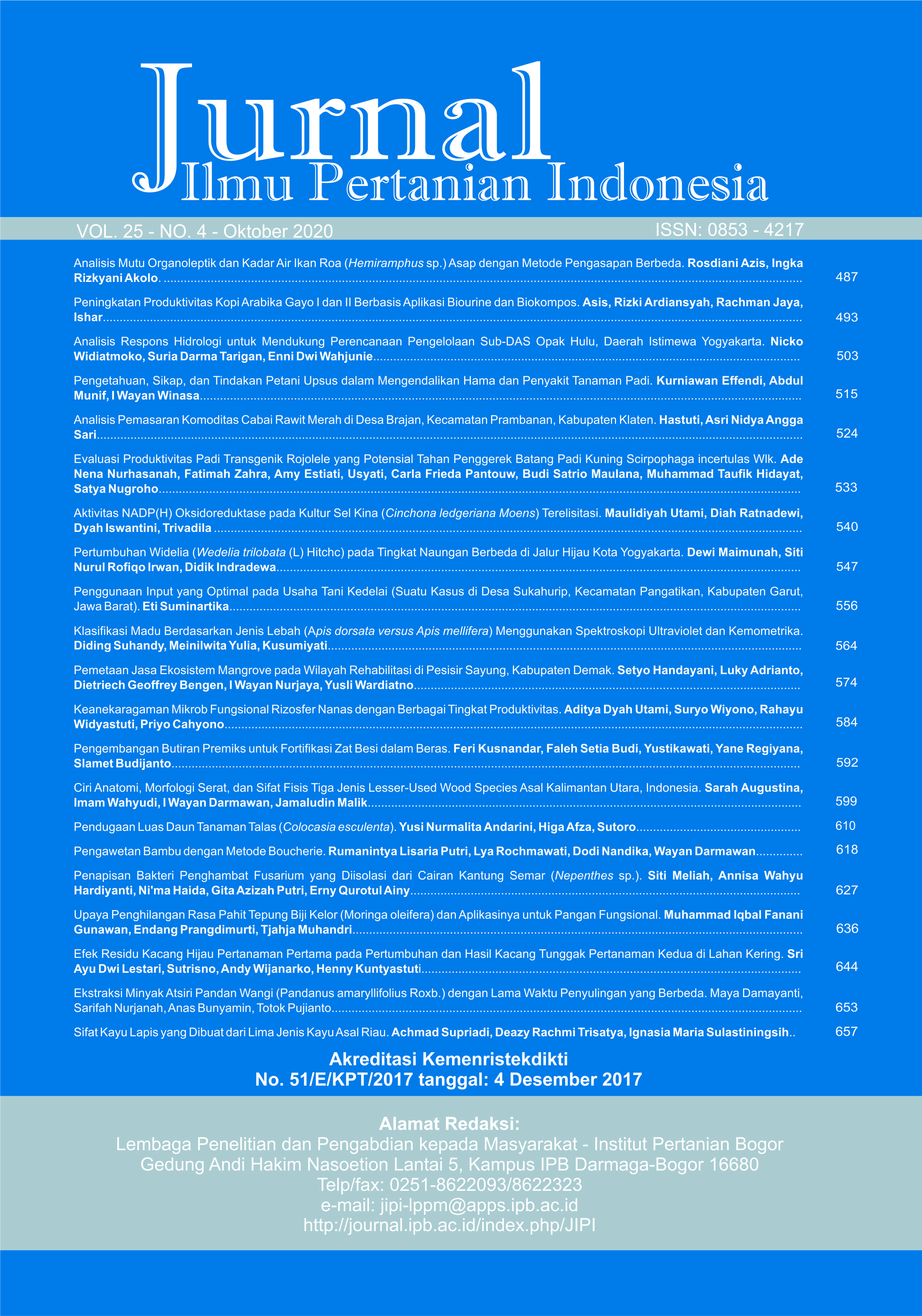Analisis Mutu Organoleptik dan Kadar Air Ikan Roa (Hemiramphus sp.) Asap dengan Metode Pengasapan Berbeda
Abstract
Fish is one source of high protein and included a commodity which is easily to decay. The way to inhibit the decay process of fish is fumigation. One of the smoked fishes that is often consumed by Gorontalo people is smoked Roa fish (Hemiramphus sp.). Smoked Roa fish is processed with traditional way through burning using woods as the fuel. Simply or conventionally fish processing like that has several flaws such as less protected of the sanitation aspects in the processing protocol. In order to improve the traditional processed product of Gorontalo, that is a smoked Roa fish, a new breakthrough in making smoked Roa fish was made by using the liquid smoke method. Liquid smoke contains compound of phenol and organic acids that are antibacterial and antioxidant compounds. The purpose of this research is to evaluate the effect of using different fumigation methods on organoleptic quality (appearance, smell, taste, and texture) of smoked Roa fish. The fumigation methods used were fumigation with liquid smoke and fumigation with traditional method. This research used a completely randomized design with 2 treatments and 3 times of replications. The results showed that liquid smoked Roa fish were preferred by panelists, compared to traditional smoked Roa fish. Liquid smoked Roa fish had a bright appearance, the smoke color was spread evenly (uniform), the smell of soft smoke, delicious fish taste, and hard texture that were different from traditional smoked Roa fish which appearance tended to be dull, the color of the smoke was not evenly distributed, the smoke taste in the fish was also quite sharp. Liquid smoked Roa fish also had a lower water content than traditional smoked Roa fish. Statistical tests showed that the fumigation method had a significant effect on the smell and water content of smoked Roa fish.
Keywords: hedonics, liquid smoke, organoleptic, Roa fish, traditional fumigation
Downloads
References
[AOAC] Association of Official Analytical Chemists. 2005. Official Methods of Analysis. Washington (US): Benjamin Franklin Station.
Adawyah, R. 2008. Pengolahan dan Pengawetan Ikan. Bumi Aksara. Jakarta
Katiandagho Y, Siegfried B, Albert RR. 2017. Pengaruh Konsentrasi Asap Cair dan Lama Perendaman terhadap Mutu Organoleptik Ikan Kayu (Katsuo-bushi). Jurnal Media Teknologi Hasil Perikanan. 5(1): 1-7. https://doi.org/10.35800/mthp.5. 1.2017.14877
Leiwakabessy J, Wenno MR. 2019. Penambahan Asap Cair Mampu Mempertahankan Profil Asam Lemak Ikan Tuna Kering Blok. Jurnal Pengolahan Hasil Perikanan Indonesia. 22(3): 520-525. https://doi.org/10.17844/jphpi.v22i3.29080
Patty NC, Dotulong V, Ketut IS. 2015. Mutu Ikan Roa (Hemirhamphus Sp.) Asap yang Ada di Pasar Tradisional di Kota Manado yang Disimpan pada Suhu Ruang. Jurnal Media Teknologi Hasil Perikanan. 3(2): 45-54. https://doi.org/10.35800/ mthp.3.2.2015.10354
Pratama RI, Sumaryanto HJ, Santoso, Zahirudin W. 2012. Karakteristik Sensori Beberapa Produk Ikan Asap Khas Daerah di Indonesia dengan Menggunakan Metode Quantitative Descrptive Analysis. Jurnal Pascapanen dan Bioteknologi Kelautan dan Perikanan. 2: 117-130. https://doi.org/10.15578/jpbkp.v7i2.253
Setha, B. 2011. Pengaruh Penggunaan Asap Cair Terhadap Kualitas Fillet Ikan Cakalang Asap. Jurnal Ilmu Pengetahuan dan Teknologi. 9 (1): 28-37.
Sulistijowati S, Otong R, Jetty N, Eddy A, Zalinar U. 2011. Mekanisme Pengasapan Ikan. Bandung (ID): Unpad Press.
Suroso E, Utomo TP, Hidayati S, Nuraini A. 2018. Pengasapan ikan kembung menggunakan asap cair dari kayu karet hasil redestilasi. Jurnal Pengolahan Hasil Perikanan Indonesia. 21(1): 42-53. https://doi.org/10.17844/jphpi.v21i1. 21261
Syahraeni K, Darmadji P, Hidayat C, Supriyadi. 2014. Sifat Fisikan dan Kimiawi Komponen Asap Cair Tempurung Kelapa Hasil Adsorpsi Pada Arang Aktif. Jurnal Agroland. 21(1): 7-14.
Swastawati F, Surti T, Agustini TW, Riyadi PH. 2013. Karakteristik Kualitas Ikan Asap yang Diproses Menggunakan Metode dan Jenis ikan Berbeda. Jurnal Aplikasi Teknologi Pangan. 2(3): 126-132. https://doi.org/10.17728/jatp.v2i3.142
Swastawati F, Megawati MT, Romadhon. 2014. Pengaruh Pengasapan dengan Variasi Konsentrasi Liquid Smoke Tempurung Kelapa yang Berbeda Terhadap Kualitas Ikan Bandeng (Chanos chanos Forsk) Asap. Jurnal Pengolahan dan Bioteknologi Hasil Perikanan. 3(4): 127-132
Wibowo S. 2000. Industri Pengasapan Ikan. Jakarta (ID): Penebar Swadaya.
Winarno. 2002. Kimia Pangan dan Gizi. Jakarta (ID): Gramedia Pustaka Utama.
This journal is published under the terms of the Creative Commons Attribution-NonCommercial 4.0 International License. Authors who publish with this journal agree to the following terms: Authors retain copyright and grant the journal right of first publication with the work simultaneously licensed under a Creative Commons Attribution-NonCommercial 4.0 International License. Attribution — You must give appropriate credit, provide a link to the license, and indicate if changes were made. You may do so in any reasonable manner, but not in any way that suggests the licensor endorses you or your use. NonCommercial — You may not use the material for commercial purposes.























